
Aluminum Foil Boat Lab
Try this FUN and Simple STEM Aluminum Foil Boat Lab! The absolute best STEM projects are the ones that are easy, cost effective, and allow you to teach a greater topic. It is the STEM activity that is the vehicle for which the harder to understand content follows. Funny, huh? Wouldn’t it be nice if there was a STEM activity for all things difficult to understand?!? Happy learning!

As a Christian Book and Amazon affiliate, we may earn commissions from qualifying purchases. Thank you for your support. As always, we only recommend items that we truly feel will benefit your homeschooling experience. We appreciate it.
Aluminum Foil Boat Lab Materials List
The materials list for the Simple STEM Aluminum Boat Lab is short and super inexpensive! All you need is some aluminum foil sheets and marbles. I purchased both of these from the Dollar Tree. You will more than likely need 2 to 3 bags of marbles and just 1 box of aluminum foil sheets. So, for less than $5 dollars, your student can experience an interactive lab and have a container of marbles leftover for play later.

Make your Aluminum Boat
From the picture, you can see our creations. All of the kids made their own aluminum foil boat. They were allowed to use up to 2 pieces of aluminum foil sheets, but they didn’t have too.

Some kids were more concerned with the design of their boat, while others were struggling to create a boat that they were pleased with. I gave these children a boat cheat… if you take a plastic bowl, turn it over, and then lay the aluminum foil sheet on top, you can mold the foil in the shape of the bowl. Next, turn it over and you have an instant boat!
Make Predictions
Prediction time! Now, take a look at the created boats and predict which boat you think will hold the most marbles while floating in water. The prediction sheet allows for the data collection of 6 boats. For us, each of the kids and I made a boat. If I had less children, even an only child, I would encourage my child to make 3 boats while I made 3 boats too.

After labeling each boat, 1-6, the kids and I observe the boats and one by one each child makes their predictions. I put a small star in the boat box to represent their prediction. Three of my kids predicted that the long boat below would win by holding the most marbles. SPOILER ALERT: It didn’t hold the most.
Test Predictions

We tested our boats in the bathtub, but a large sink or pool will do too. It is important to talk to your kids about how to put the marbles into their boats. For instance, dropping or thrusting your marble at the boat may sink it like a bomb would a pirate ship. Encourage them to carefully and easily place the marbles into their aluminum foil boats as they count out loud. FYI: One boat was lost to marble bombing… 3 year old pirate.

If you have multiple children, I would suggest making this a rule: the person who made the boat is the only person allowed to add marbles to that boat. The person adding the marbles is responsible for counting out loud. Once the boat begins to sink, all marbles hence to be added to the ship. There is a lot of commotion when the boat starts to sink. Everyone gets pretty riled up… it’s fun… even for mom!

Record Data
Tally marks are configured to represent the number of marbles the boat held and then the sum is written in number form and circled to show the total. The data collection process allows for counting over 100, skip counting by 5’s, and how to write tally marks.

Analyze Data & Make Conclusions
By the end of the Aluminum Foil Boat Lab, we had plenty of observations to share. We discussed what kind of design held more marbles and why some boats sank quicker than others. They each explained how they would have built their boat different, or not. The simple STEM Aluminum Foil Boat lab was a fun and educational science exploration for the whole group.

Extend the learning...
Sure, we could have called it a day and stopped with only the STEM lab, but this was the perfect opportunity to extend the learning! Take a look at What causes a boat to float? and learn how Density, Buoyancy, and Displacement all play a role in the floating of a boat!

Food for thought...
Looking for a more permanent science curriculum? Even though we pursue various science units that encompass labs and such, we also use a science textbook each year. Some might say that our science units supplement our textbook, while others would say the opposite to be true. The labs, experiments, graphic organizers, videos, and other activities bring the textbook information to life.

We use Abeka Science textbooks. I love that they incorporate God and His sovereignty into their curriculum. When I taught in the public school system, I noticed that many of my students were lacking in vocabulary. This made it difficult for them to understand the why behind many of our investigations. Unfortunately, they were deficient in their background knowledge. Our science time would be lacking too if it weren’t for the rich vocabulary and science language that we find in our science textbook and readers. If you are interested in shopping for a full-time science curriculum or even just a textbook to guide you, click on the following link! Happy homeschooling!
Check out these other FREE resources!

Share this:

Aluminum Foil Boat Challenge (Penny Boat Challenge)
The aluminum foil boat challenge also known as the penny boat challenge is a fun STEM lesson for kids of all ages. This is an easy and fun science experiment that can be done at home or in a classroom.
The object of the penny boat challenge is simple, your child will design and build a boat from aluminum foil and see how many pennies it can hold before it sinks.

The science lesson is that things float when they have less density than water and will sink then they have more density than water.
Try to make several different kinds of boats to see which one holds more pennies. Does the shape of the boat affect how well it floats?
You can turn this STEM activity into a fun competition. You can have each child make a foil boat and then see which boat holds the most pennies.
Hree is the lesson that I learned doing the aluminum foil boat challenge with my kids: make sure the kids don’t make too big of a boat or you will run out of pennies.
My daughter turned her aluminum foil into a boat shape. My son made a small foil bowl. My daughter’s foil boat held more pennies.
Then, they worked together to make a big boat. With the big boat, we ran out of pennies, then added dimes and then added quarters before it finally sank. The kids loved it.
This post contains affiliate links. This means at no extra cost to you; I may earn a small commission if you decide to make a purchase. For more information, please read affiliate policy .
Foil Boat Challenge Teaches:
- Science: The science word of this STEM activity is buoyancy. Buoyancy is how well something floats. Did the boat with the larger surface area hold more pennies or did the boat with the smaller surface area hold more pennies?
- Engineering: Design and build a foil boat.
- Counting: Have your child count the pennies as she places them on the foil boat.
- Research: Look up how boats float with your kids.
- Read: Read some great books about boats with your kids.
Penny Boat Challenge Supplies
- Aluminum foil
- A large container to hold water
How To Complete The Aluminum Boat Challenge
Fill a large container with water. If you are doing this STEAM activity at home, you can use the sink or bathtub.
Give your child a piece of aluminum foil and have them design and build a boat.

Then, float the aluminum boat on water. Add pennies one at a time until the boat sinks. How many pennies did it take for the boat to sink?

Other Kids Activities That You May Like
Kids love playing with bathtub paint. Here is a recipe to make your own.

This cardboard tube construction toy provides hours of fun.

Share this:
Leave a reply cancel reply.
Notify me of follow-up comments by email.
Notify me of new posts by email.
GET OUR LATEST UPDATES!

Aluminum Foil Boats: Easy STEM Craft for Kids
- Kindergartner
- Preschooler
In the realm of creative and educational activities, constructing a boat with everyday materials can be a thrilling and educational experience. In this blog post, we will explore the process of crafting an aluminum foil boat using a tissue box as its sturdy base. To add to the excitement, we’ll also create a sail made from a foam sheet. Let’s set sail on this delightful DIY project!
WILL YOU TRY MAKING AN ALUMINUM FOIL BOAT CRAFT WITH YOUR CHILD THIS SUMMER? Pin it for later!

Materials Needed
- Aluminum foil
- Glue or tape
- Marker or pen
- Water or bathtub (for testing)
Crafting Adventure: Building an Aluminum Foil Boat
Step 1: preparing the tissue box structure.
To begin, find an empty tissue box that is no longer in use. The tissue box will serve as the foundation for your aluminum foil boat. Cut a piece of cardboard the same height and length as the tissue box. Fold the piece of cardboard in half and tape it to the front or short side of the tissue box to create the point or front of the boat.
NOTE: When I was constructing our boat I only got he idea of adding the cardboard piece in the front after we had already covered the tissue box in foil. So that is why my pictures show my son wrapping just a box. You can learn from my mistake and tape on the cardboard piece on the front before wrapping the foil.

Step 2: Wrapping the Tissue Box with Aluminum Foil
Take a sheet of aluminum foil and carefully wrap it around the outside of the tissue box. Add several more sheets to ensure that the entire box is covered with at last two layers of foil. Tuck the foil around the tissue box opening to secure it into place.You want keep the tissue box opening open for the sail(s). Remember to cover all sides of the tissue box, ensuring a watertight seal.

Step 3: Constructing the Sail from a Foam Sheet
Next, grab a foam sheet in a color of your choice. Using a marker or pen, draw a sail shape on the foam sheet. Feel free to get creative with the design! Once you are satisfied with the outline, carefully cut out the sail along the marked lines. Make sure the size of the sail is appropriate for the boat, allowing it to catch the wind effectively.
Use scissors to poke a hole Position the sail on the boat, determining the ideal placement for optimal stability and wind-catching ability. Glue or tape the base of the sail securely to the top of the tissue box. Ensure that it stands upright without tipping over.

Step 4: Testing the Aluminum Foil Boat
Now comes the exciting part – testing your newly crafted boat! Fill a basin or bathtub with water or if you have a lake or pin close by head out there. Place your aluminum foil boat gently in the water, ensuring it floats steadily. Observe how it glides on the surface and how the sail catches the air when you blow on it, propelling the boat forward. Make any necessary adjustments to the sail’s angle or position to improve its performance.

Step 6: Experiment and Enhance
Once you’ve successfully tested your boat, don’t hesitate to experiment further. You can add more sails, decorate the boat with markers or stickers, or try different techniques to enhance its stability or speed. Feel free to enlist friends or family members to join in the fun and create a fleet of aluminum foil boats.
Crafting an aluminum foil boat using a tissue box structure and adding a foam sheet sail is an enjoyable project that combines creativity and exploration. It allows you to learn about buoyancy, stability, and the effects of wind on sailboats while igniting your imagination. So, gather your materials, set sail on your DIY adventure, and let your aluminum foil boat glide across the waters of discovery!
Science Behind the Foil Boat
Did you know that aluminum foil can float on water? It’s pretty cool, right? Let’s find out why! You see, aluminum foil is very light, and that’s why it can float.
Age Suitability
This activity is good for toddlers aged children 2 years old and up with adult assistance.
The mess level for this activity is low.
Difficulty to Create
Skills developed.
Language development, shape recognition, color recognition, hand-eye coordination, fine motor skills, imaginative play, creativity.
Toddler and Preschooler Curriculums, Books & TV Show!
Play2learn toddler & preschool programs for curious toddlers.
There is no limit to your toddler’s energy and curiosity. That energy and curiosity although a joy can be challenging at times. Their interest in just about everything around them is what makes them great learners. One and two year olds can soak up so much just from their senses!
But as a teacher or parent that thirst for learning can be exhausting. That is why I created this toddler and preschooler program. To help you get the most out of this time with your curious toddler without having to come up with creative ways to play and interact with them.
Play2Learn for Toddlers includes 20 Units for toddlers. Each 2-week toddler unit has 20 super easy to set up and engaging activities for toddlers 18 months to 3 years.
Play2Learn Preschool which includes 20 Units for preschoolers. Each 2-week preschoolers unit has 20 unique and easy to set up and engaging activities for preschoolers 3 years to 5 years. That’s over 800 learning activities for your toddler and preschooler at your fingertips! So many ideas you and your child will never be bored again!
These toddler and preschool lesson plans and activities will definitely keep you and your toddler and preschooler busy playing and learning!
Click here for more information: Play2Learn
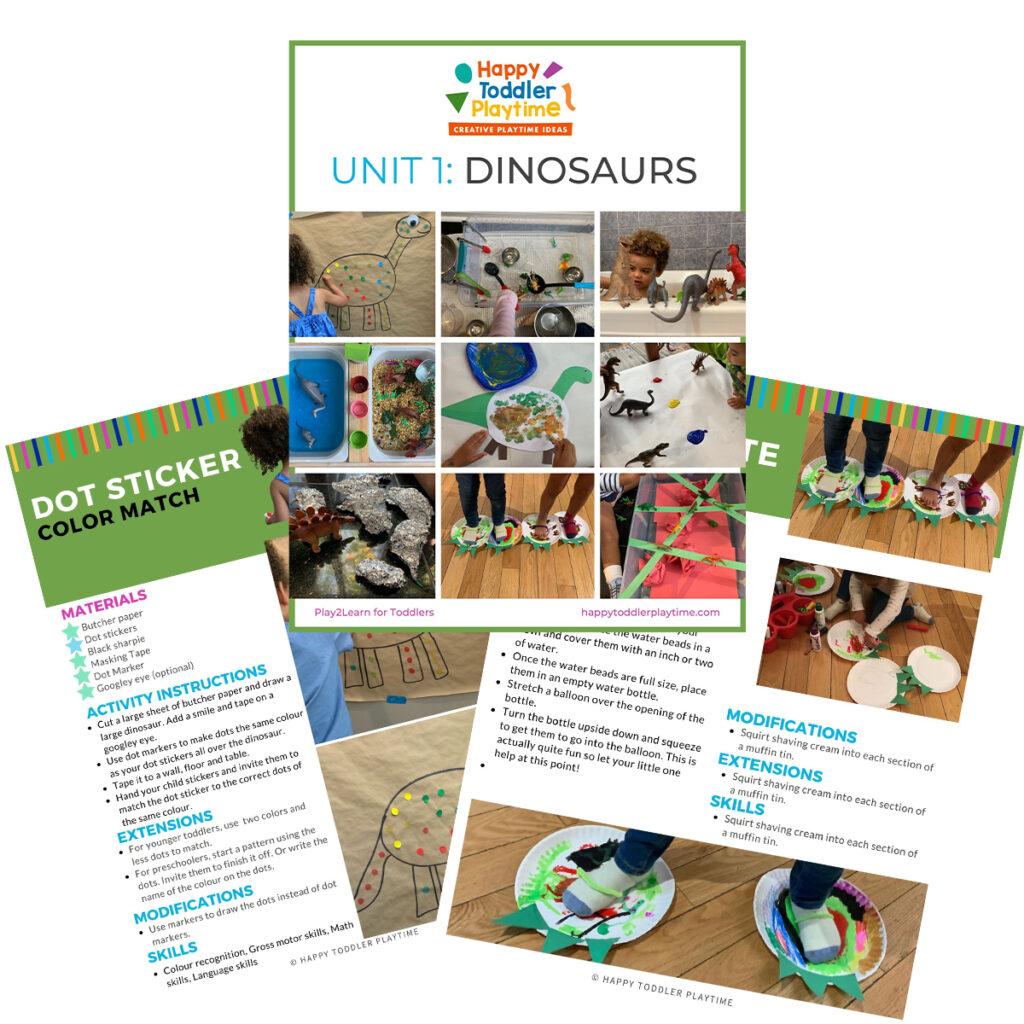
Designed for toddlers 18 months and up.
Book: Exciting Sensory Bins for Curious Kids
Did you know I wrote a book of sensory bins? Click here for more information Exciting Sensory Bin for Curious Kids . Or grab your copy at Amazon .
Boring afternoons are made exciting with awesome animal-based bins, like Salty Shark Bay or Yarn Farm. Pretend play bins like Birthday Cake Sensory Play or Bubble Tea Party encourage creativity and imagination. And your kids will have so much fun they won’t even know they’re getting smarter with STEAM (science, technology, engineering, art and math) activities like Sink or Float Soup, Magnetic Letter Hunt or Ice Cream Scoop and Count.
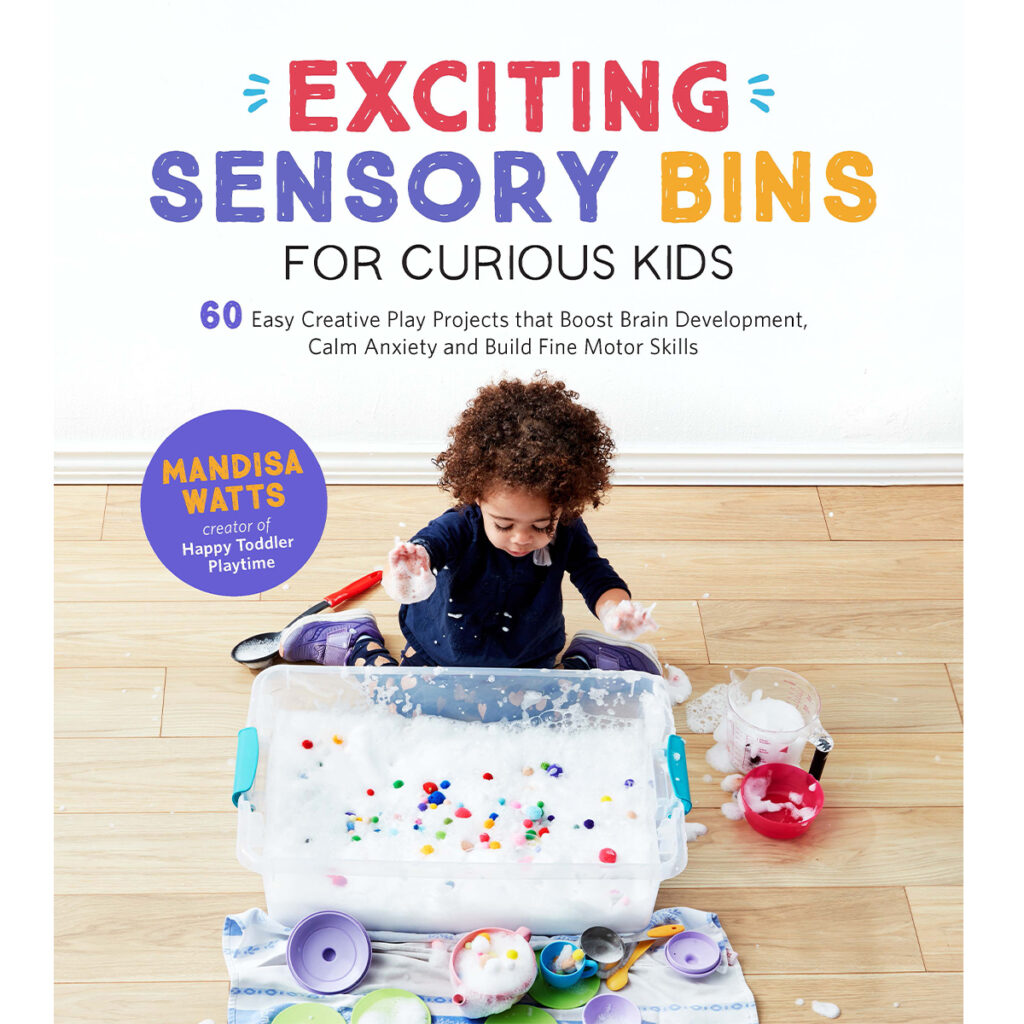
Book: Super STEAM Activity Book for Kids
Learning all about science, technology, engineering, art, and math sets kids up for scholastic success―and it can be so much fun! Watch kids enjoy building STEAM skills as they color friendly fish, help water find its way to tree roots, solve math problems with mazes, and more.
Find out more and grab your copy here .
Designed for preschoolers 3 years old and up.

Book: Big Book of Riddles for Kids
Riddle me this: What’s an exciting way to practice critical thinking while having a blast? The Big Riddle Book for Kids , of course! From hilarious puns to tough brain teasers, kids can build problem-solving skills with hundreds of riddles that show them how to think outside the box.
- 350 riddles for kids —Have hours of fun with riddles, puns and jokes, and math and logic puzzles that’ll get their wheels turning!
- Level up their skills —Riddles get trickier as kids progress through the book, challenging them as they get better at solving puzzles!
- Double-check their work —Kids can check their answers in the back of the book with a handy answer key.
Help children expand their minds while having fun with this puzzle book for kids!
Designed for kids ages 6 years old and up.

TV Show: Curious Crafting
I’m so excited to share my crafting TV show Curious Crafting which launched in July 2022 on TVOkids and TVOkids YouTube ! Season 2 airs in the summer of 2023! We were also nominated in 2023 for Best Live Action Preschool Series by the Youth Media Alliance Awards of Excellence.
Set in the ultimate crafting space, Curious Crafting is a short form pre-school age series about the joy of making crafts. I lead a rotating cast of adorable little preschoolers (including my own) making magic out of common household objects.
In each episode we transform recycled items into magical crafts like a milk carton school bus, paper bag puppet or cotton pad turtle. The crafters learn and laugh their way through each activity while demonstrating what their young imaginations can create.
Curious Crafting shares the adventure and joy of making art with takeaway lessons for creating crafts at home.
This show designed for toddlers and preschoolers 2.5 years old and up.
Filed Under:
- Cardboard Crafts
Other Posts You May Like...
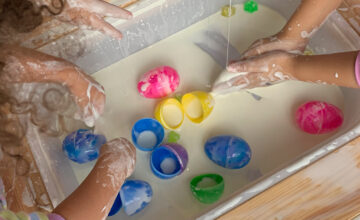
Easter Oobleck Sensory Bin
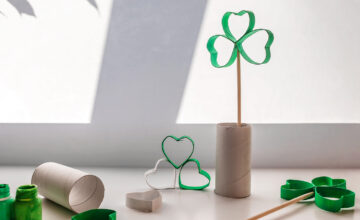
Toilet Paper Roll Clover Wand

Bumblebee Sensory Bin

Paper Easter Wreath
Review and rate this post cancel reply.
I love hearing from you! Submit your question or review here. Your email address will not be published. Required fields are marked*.
This site uses Akismet to reduce spam. Learn how your comment data is processed .

How to Make Recycled Raingutter Regatta Boats
- Facebook 954
- Pinterest 2226
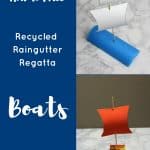
Packs can have a simple Raingutter Regatta by turning it into a Recycled Raingutter Regatta! For this environmentally friendly activity, you don't need kits–just stuff from your recycling bin and a few supplies.
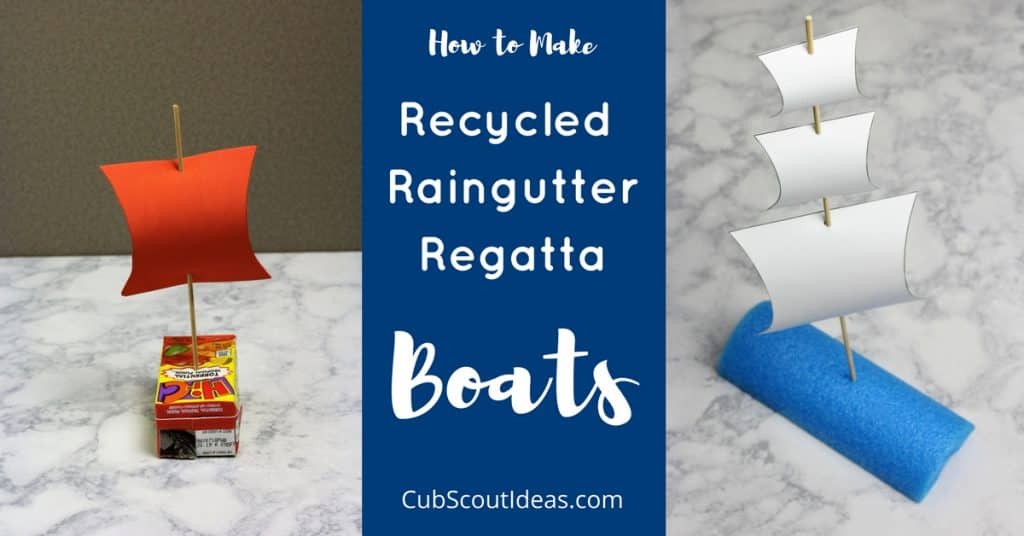
The Raingutter Regatta is a fun Cub Scout activity. The Scouts use a kit to build a trimaran sailboat that is “wind-powered” by blowing on the sail. They can work to make their boat more aerodynamic, and they can decorate it. The Cub Scouts then race their boats in water-filled rain gutters at a pack meeting.
But much like the Pinewood Derby, the Raingutter Regatta is an EVENT. It takes planning and effort to host one.
Instead, have a Recycled Raingutter Regatta that takes very little preparation time or money .

Raingutter Regatta Track
The traditional Raingutter Regatta uses 10′ gutters with end caps attached. Vinyl gutters are better because they won't bend as easily when filled with water. The problem is someone has to try to find a place to store 2 10′ gutters !
A much easier option is to purchase an inflatable track . ScoutStuff has one for less than $30 . While it's a bit more expensive than buying gutters, I believe the ease of use is well worth the extra money.
Another way to build a track is with a split piece of PVC pipe. You do need to build a frame for the pipe so it won't roll.
This image shows the track that our Cub Scout day camp borrowed from a local pack. You can see how they cut half circles in the planks for the pipe to fit in. Here are some instructions on how to build a track like this .

Supplies to Build Boats
Send a quick email to each family to ask them to raid their recycling bins for items that can be used to build boats.
- Plastic water or soda bottles
- Plastic milk jugs
- Paper milk cartons
- Styrofoam food trays
- Small plastic food containers
- Empty juice boxes
- Pool noodles (laying around the garage)
- Aluminum foil
- Aluminum food containers
You'll also want to have some of these items available. If you don't have a fully stocked den bucket , ask parents to check their craft supplies.
- Craft sticks
- Construction paper
- Foam craft sheets
- Hot glue gun & glue sticks (Only parents should use this)
- Bendable straws
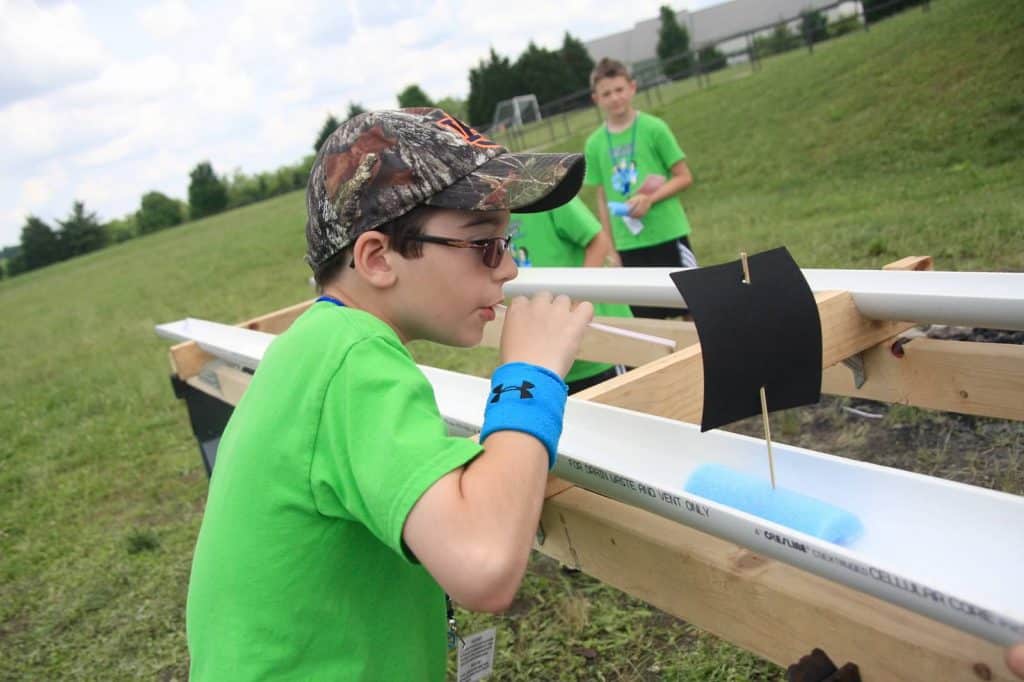
You definitely want straws for the Scouts to blow through. The boats move better with a thin stream of air rather than a big puff. Plus, asking little Scouts to blow means you're going to get some spit too! 🙂
Depending on how creative your Scouts are, you might need to build a couple of example boats to give them some ideas.
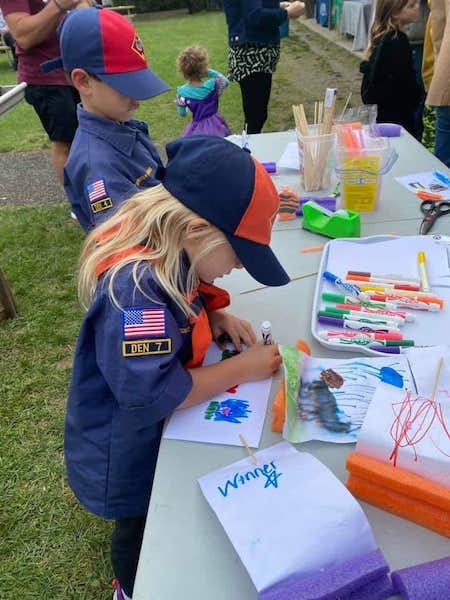
Discuss Recycling
If you have a big pack, you probably won't have time to do this part.
When the Scouts first arrive, spend a couple of minutes talking about recycling . You can start by asking them how long they think it will take for trash to decompose if it's just thrown outside.
This infographic has great information! You can click here to get your own copy .
I'm sure you'll get some crazy answers from the Scouts. Do you think any of them will guess a million years for a glass bottle?
The Leave No Trace organization has an excellent trash timeline activity . Taking abstract concepts like trash decomposition time and turning them into an active game is one of the best ways to learn, in my opinion.
You might also want to check out this fun recycling game that I did with my den.
Boat Building Instructions
After you've completed the recycling discussion, tell the Scouts that they'll be designing and building a boat from the recycled materials. Set out all of your supplies so that they can see what they have to choose from. Show them the examples, if you have any.
During the summer of 2016, my boys and I made our second trip to the Philmont Training Center where I took a class called Fun with Dens and Packs .
This was such a fun and informative class! Our instructors were Kee Ostler, Julianne McCracken, Pam Startzel, and Amy Hutcherson. These Scouters did an awesome job planning and executing our class.

One of our activities was a Recycled Raingutter Regatta. We made three different types of boats, and the instructions for them are below. But these aren't the only types of boats that can be built with recycled materials. Let the Scouts use their imaginations to see what they come up with!
For each type of boat, you'll need a sail. Sails can be several different shapes: triangular, quadrilateral, or square.
You can make your sails out of just about anything : construction paper, scrapbook paper, white or colored printer paper, cardstock, or even craft foam. I like the craft foam because if it gets wet, it won't destroy the sail.
There are several ways to make your sails.
- Have the Cub Scouts cut their own out by hand.
- Print sail images and have the Scouts cut them out.
- Print sail images onto cardstock so the scouts can use them as templates to trace the shapes onto paper or cardstock.
Suz from Little Handmade Party Company has a printable with some great sail shapes ! She and her son actually used them to turn mini baguette pizzas into boats. Be sure you hop over and see how they did it !
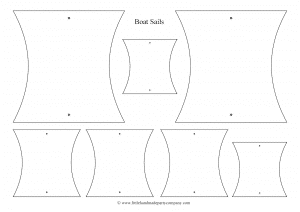
I contacted Suz, and she graciously agreed to let me share her template with you. You can get this one and the two others at the bottom of the page.
Check out these fun sails! They have the Cub Scout logo on them. Lorraine from Auburn, WA made these. Her Cub Scout is now grown, but while he was a scout, Lorraine was her pack's treasurer, and her husband was the Cubmaster.
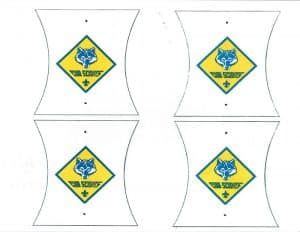
Lorraine's pack used these boats as a recruitment tool at a school fair. Everyone got to build a boat and race it. They took the boat home along with a Cub Scout flyer. I love this idea!
You can get this one and the two others at the bottom of the page.
I created a template for those of you who would prefer a triangular sail. Enter your email to get the free download.
Get your Free Sail Template
Enter your email to get your Cub Scout Sails printable!
If you don't get an email within 10 minutes, check your spam folder. If it isn't there, let me know at [email protected] .
After your Scouts finish cutting out their sails, they can decorate them by drawing on them with crayons or Sharpies or by adding stickers. ( Pirate stickers would be super fun to use!)
Aluminum Foil Boat
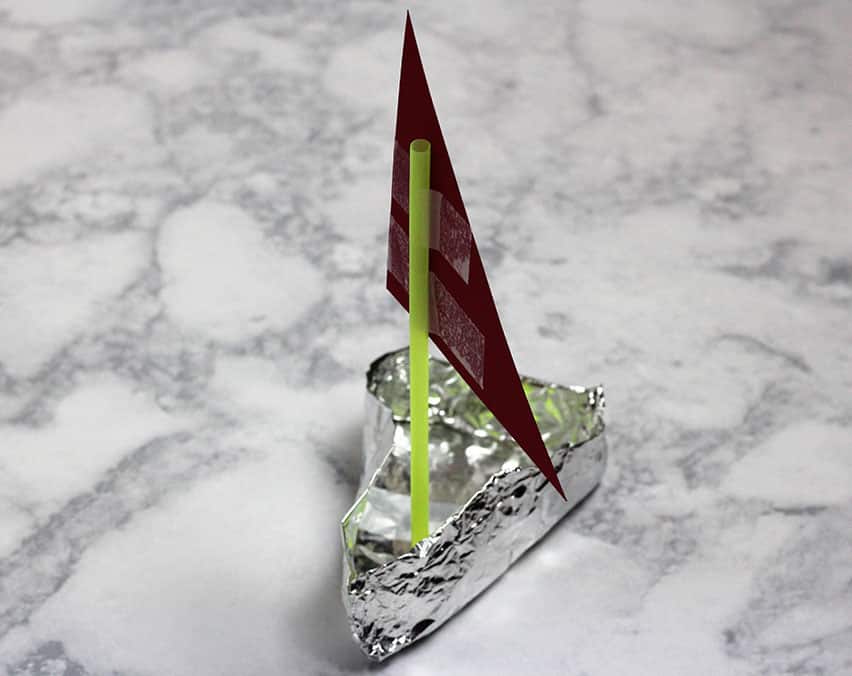
You'll need to double the aluminum foil. I think heavy duty foil works best.
Make a boat shape by bending and folding the foil. Cut a triangular sail from paper. Use a bendable straw for the mast.
Bend the straw, and tape the short end to the bottom of your boat. Decorate the sail any way you like.
I didn't have much luck with the aluminum foil boat! Mine just didn't want to go anywhere. I suspect it's because I had a hard time imagining how to shape the boat.
Juice Box Boat
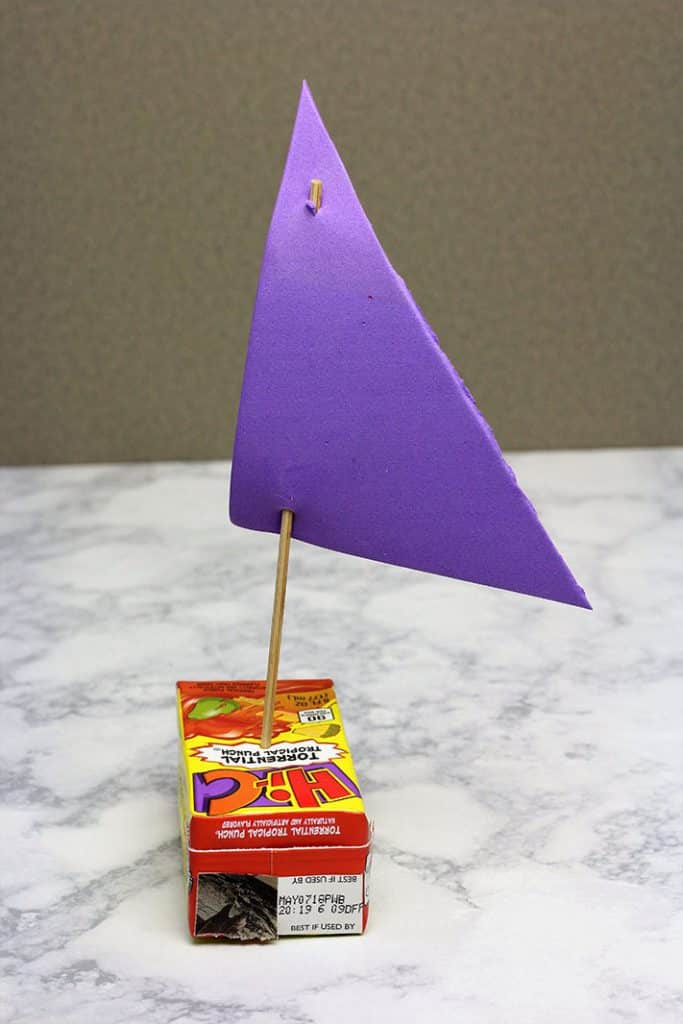
For this boat, you'll need an empty juice box and some duct tape. Use a bit of duct tape to cover the straw hole.
Have the Scouts put the box on the table, seam side down. Hold the sides of the box with one hand, and use the skewer to poke a hole in the box.
If you're using a craft stick for the mast, you'll need to use something to make a slit in the box. A letter opener is a great alternative to a knife.

Note: Please make sure you have adequate adult supervision especially for the younger Scouts. Only adults or Scouts with their Whittling Chip should use a knife. The skewers have pointed ends, so be careful with those too.
Attach the sails to the skewer or craft stick, and insert into the opening you made on the box.
Pool Noodle Boat

Pool noodle boats are my favorite kind to make! We actually did this at Cub Scout day camp a few years ago. We purchased the noodles in bulk from Dollar Tree .
Then my husband used a table saw to cut them up for us. He cut the noodles into pieces about 6″ long, then split those in half.
We thought the scouts would be able to decorate the noodle with Sharpies, but the ink didn't dry even after letting it sit for a while. I guess it makes sense–something that's supposed to float probably shouldn't absorb any liquid!
One of the reasons that I like using the pool noodles is that it's easy to poke the mast into the noodle. You can cut the tip off of the skewer or use a dowel with no point. Even craft sticks are easy to push into the noodle.
If your families don't have old pool noodles laying around the garage and you'll have to purchase them, the activity becomes more of a regular Regatta rather than a Recycled Regatta.
Racing the Raingutter Regatta Boats

The Scouts will pair up to race each other. You can let this just be a fun activity where you aren't keeping track of who wins, or you can set up a tournament.
If you do a tournament, you might want to use this resource to print your brackets. The link goes to the double elimination bracket page .

Cub Scout Adventures
Tigers and Wolves can count this activity toward elective adventures.
Tiger Floats and Boats 6. Build a boat from recycled materials, and float it on the water.
Wolf Air of the Wolf 2 E. With your family, den, or pack, participate in a kite derby, space derby, or rain gutter regatta. Explain how air helps the vehicle move.
Hope your pack enjoys your recycled Raingutter Regatta!
Yours in Scouting, Sherry
P.S. Another way to do this is by making it an engineering design challenge . You can read about that on the Scholastic blog . I like the idea of the scouts working together.
P.P.S. Sign up below to get more great ideas!
Bridget Hurt
Monday 26th of February 2024
If you could please send me the template discussed above it would be greatly appreciated!
Kimberly Chromicz
Friday 1st of March 2024
I’ve emailed you the printable. Enjoy!
Tuesday 19th of December 2023
Hi Kimberly, Can I get the template for the Raingutter Regatta sails and as well as the one with the Cub Scout logo on them too?
Friday 29th of December 2023
I've emailed you the templates. Enjoy!
Tuesday 12th of September 2023
Could you please send me the sail template? Thank you.
Friday 15th of September 2023
I've emailed you the sail template. Enjoy!
John Brinkman
Monday 4th of September 2023
I am wondering if I could get the template for the sails.
Monday 11th of September 2023
Hi there, Apologies for the late response, I was out of town. I've emailed you the Raingutter Regatta Sails template. Enjoy!
Thursday 17th of August 2023
Looking to get the logo template for a recruitment event coming up. Thank you!

To provide the best experiences, we use technologies like cookies to store and/or access device information. Consenting to these technologies will allow us to process data such as browsing behavior or unique IDs on this site. Not consenting or withdrawing consent, may adversely affect certain features and functions.

Participants design and build a boat from aluminum foil that holds as many pennies as possible before it sinks or capsizes, learning about buoyancy, density, and displacement.
- 45 minutes or Less
- Materials Science
- Design Challenge
- Forces, Motion & Energy
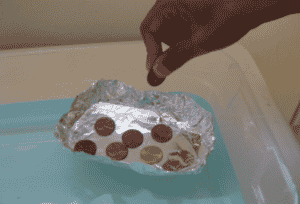
Supplies & Equipment:
- Shallow plastic bin
- Pennies (several hundred) or other weights
- Optional: pictures of different kinds of boats
Consumables:
- Aluminum foil
GETTING READY
Cut the foil into uniform squares. The foil squares can be anywhere from 4″ x 4″ to 12″ x 12″. Keep in mind that larger squares will make larger boats, which may require more pennies to sink. Fill your plastic bin with a few inches of water. Have towels ready to dry your hands or clean up spills.
INTRODUCTION
Ask questions to get participants thinking about why objects sink or float:
- Think about different boats you have seen. What is the same about them? How are they different? (Similar shapes or materials, different means of propulsion, etc.)
- What makes a boat float? (Boats weigh less than the water they push aside.)
- What’s a common way to ship things across the ocean? (Cargo ship or freighter.) Some cargo ships travel with a load of containers that is larger than the ship—why do you think it doesn’t sink? (Their flat, hollow design keeps them buoyant.)

Participants place pennies in their boat one at a time. Be sure to have them distribute the weight evenly. Credit: Maria Kapadia/Science 4 Superheroes.
Ask participants more focused questions about buoyancy. What happens to a full glass of water when you add a bunch of ice cubes to it? What happens to a ship when more and more weight is added to it?
Introduce the design challenge.
Give each person or team a square of aluminum foil.
Give participants as much time as they need to build their boats. They may test them to make sure they float before adding weight.
Start adding weight to the boat. Make sure to distribute the weight evenly.
- Place pennies one by one into the boat. Participants can keep track or count along.
- Keep adding weight until the boat sinks.
- Make observations along the way. Does the boat change shape, spring a leak, or lean in one direction?
Ask questions to encourage further discovery. Redesign the boat and test again.
ACTIVITY VARIATIONS
Calculate the weight of displaced water just before sinking. Add the weight of the dry foil boat plus the weight of the pennies. A standard US cent weighs 2.5g. Was this more or less than you thought the boat could hold?
Use other materials for building the boat, like clay or paper.
After testing a boat in water, try another fluid. Will the boat hold the same amount of weight floating on salt water? What about vegetable oil?
TROUBLESHOOTING
If a boat doesn’t remain upright, consider a wider design.
If a boat sinks before you think it should, make sure you are distributing weight evenly.
Wide, flat-bottomed boats will hold the most weight. If participants are frustrated, give them hints but try not to blatantly tell them how to build their boat.

Barges are wide, flat-bottomed boats designed to carry heavy loads, like this replica space shuttle. Credit: NASA.
Buoyancy : An object’s ability to float in water or other fluid.
Density : How much something weighs as compared to how big it is—or, an object’s mass per unit volume. Something big and light, like a balloon, has low density. Something small and heavy, like a rock, has high density.
Displacement : The moving of something from one place to another. For example, when an object is placed in water, it pushes some water out of the way and takes its place.
GUIDANCE FOR YOUNGER CHILDREN
QUESTIONS TO ASK AFTER THE ACTIVITY
- What kind of real-world boat did your boat look like?
- How many pennies was your boat able to hold? Did it matter how or where you placed the pennies in your boat?
- After testing your boat, did you make any changes to the shape of your boat? Why or why not?
- What shapes seemed to work the best?
- What could you change to make your boat hold more weight before sinking?
- Did your boat tip over before it sank? And if so, what changes did you make to stop this from happening?
- Why do the pennies float when placed in the boat but sink when placed directly into the water?
GUIDANCE FOR OLDER YOUTH AND ADULTS
- What type of boat did you use as a model for your foil boat? Why did you think this would be the best idea for holding lots of pennies?
- What factors did you consider when designing your boat?
- Given more time, what changes could you have made so that your boat would hold more pennies?
- Did your boat capsize? If it did, how could you have prevented this from happening?
- Did the placement of the pennies affect your boat’s ability to float?
- How does the shape of your boat affect the boat’s buoyancy?
Engineering Connections
For a boat to float, it needs to weigh less than the same amount, or volume, of water. To make this happen, engineers must build boats so that they have giant pockets of air inside them. If you think about a huge cargo ship or a cruise ship, you will realize that most of the ship’s interior is open space. The weight of the ship is spread out across a large area so that compared to the same volume of water, the water weighs much more than the ship.
Boats have different shapes depending on what they are used for. Boats that are flat on the bottom do not sink very deep into the water because their weight is spread over a large area, making the weight of the boat less than the weight of the water that the boat pushes aside. These boats are used for traveling in shallow water. They can also hold larger amounts of weight. They would be perfect for carrying lots and lots of pennies!
Science Connections
Why does a rock sink in water while a giant cruise ship will float? An ancient Greek scientist named Archimedes was the first person to figure out the science behind what makes some objects float while others sink. He found that when an object is placed in water, it pushes enough water out of the way to make room for itself. You’ve seen this idea in action if you have ever stepped into a full tub and had the water level rise and spill over the top to make room for you.
When an object is placed in water, there are two forces that act on it: a downward force, called the object’s weight, and an upward force, which is equal to the weight of the water that the object pushes out of its way. If the downward force is less than the upward force, the object will float. This is why a rock will sink while giant cruise ships float. The rock weighs more than the amount of water that it pushes out of its way. The cruise ship, however, weighs less than the huge amount of water that it pushes out of its way.
When designing a boat, engineers give lots of consideration to the shape of its hull. The hull isn’t very noticeable because most of it is under water. However, the first question that engineers need to ask is, “How will this boat be used?” The answer to that question determines the boat’s design. For example, if the boat is meant to travel in shallow water, at very high speeds, or carry a large amount of material, a flat-bottom hull might be a good design. These boats float high in the water, thereby minimizing the amount of water that the boat must push out of the way as it cruises through it. This, in turn, reduces the friction between the water and the boat, allowing it to travel very quickly. Also, since flat-bottom boats sit fairly high in the water, they are very useful for moving around in shallow waters. However, sitting high positions the boat’s center of gravity above the surface of the water, which is not an advantage in rough seas. In this situation, flat-bottom hulls are less stable than other kinds and more likely to capsize (tip over).
Whether an object floats or sinks depends on its density and its ability to displace water. An object placed in water will displace an amount of water equal to its volume. When an object enters the water, there are two forces acting on it: the force of gravity pulling the object down, and the buoyant force of the water pushing upward. According to Archimedes’s principle, the buoyant force is equal to the weight of the water that an object displaces. Therefore, if the buoyant force acting on an object is greater than the weight of the object, the object will float. To test this, you could fill the hull of a boat with water. You could then weigh all of this water and compare it to the weight of the empty hull. If the water weighs more, then the boat will float. If the water weighs less than the boat, the boat will sink.
This version of the activity provided by Liberty Science Center. All rights reserved.
Supplemental content adapted for Dream Big Activities by the Carnegie Science Center.
Enjoy this activity?
Join our community and receive activities, early access to programs, and other special news, and/or leave feedback on this activity below!
Thank you! Your submission is processing.
Your email address will not be published. Required fields are marked *
First Name*
Save my name, email, and website in this browser for the next time I comment.
Submitting...
Submit a Comment Cancel reply

- 1 to 2 Hours
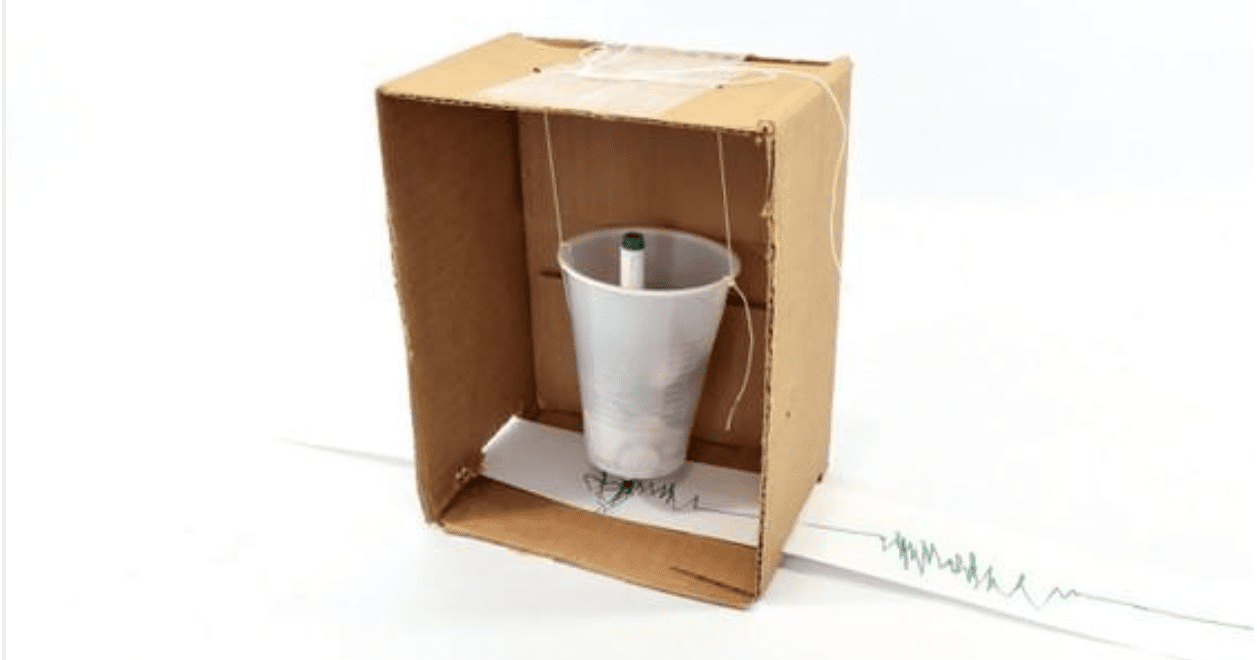
Find our resources helpful? Please consider donating.
Want to find out how you can volunteer?
Stay up-to-date with all the programs and resources that Discover E has to offer!
Testing this to see if it works
http://discovere.org
Login or Create Account
All of the content on this site is free!
Registering for the site helps us tailor future activities, webinars, and events so that we can serve you better.
Thank you for your interest and for helping us in our mission to transform lives as we put the E in STEM!
Log in or sign up
Forgot your password?
Don’t have an account? Sign up!
- Become a Member
- Event Rentals

DISCOVERY WORLD @ HOME
Aluminium foil boat.
How is it possible for a boat to float on the water? Design and construct boats out of aluminum foil and see how many pennies they can hold before they sink. Try this fun experiment today!
Aluminum Foil Boat was part of our Week 4 Theme: Density & Floating. What other projects from this theme did you participate in?
Share your creations with us at AtHome@discoveryworld.org

Inspire the next generation
When you support Discovery World, you help us enhance our experience and enrich the quality of science education in Milwaukee and beyond. From caring for our creatures to feeding hungry minds, your donation makes all the difference.
Join our newsletter for Discovery World news and updates.

Mon-Tue: CLOSED Wed-Sun: 9:00am-4:00pm
*Please check our Calendar of Events for exceptions to these hours and a list of closed dates, special hours, or early closures.
500 N Harbor Dr Milwaukee, WI 53202
- Jobs & Internships
- Press Room & Media
June 20, 2019
Surviving the Stormy Seas—with Science
A stormy science project from Science Buddies
By Science Buddies & Ben Finio
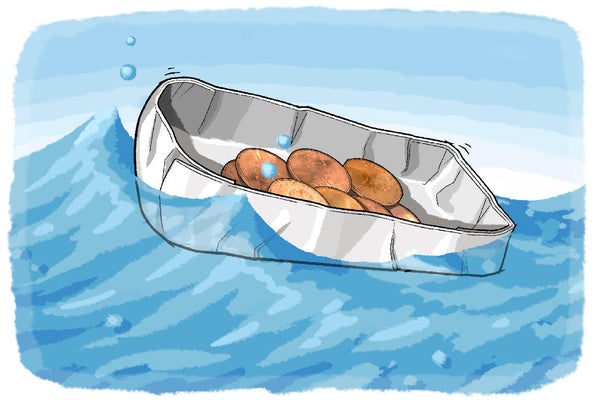
Make waves: Use a little physics and engineering to see if you can keep a homemade boat afloat--even in rough waters!
George Retseck
Key Concepts Physics Mass Volume Density Engineering
Introduction It's one thing to build a boat that can stay afloat in calm water—but what about one that can survive large waves in a storm? In this activity you'll put a new spin on a classic activity. You'll build aluminum foil boats to carry pennies as cargo, but instead of testing them in flat water you'll create your own storm to test them in waves!
Background People have used boats for transportation for thousands of years. Boats, however, can be vulnerable to storms, when high winds and large waves cause boats to flip over or fill with water and sink. How can you make a boat safer and less likely to sink in water with big waves?
On supporting science journalism
If you're enjoying this article, consider supporting our award-winning journalism by subscribing . By purchasing a subscription you are helping to ensure the future of impactful stories about the discoveries and ideas shaping our world today.
To understand what makes a boat float or sink in still water, you first need to know a little bit about mass, volume and density (mass per unit volume). An object in water is pulled down by its own weight and pushed up by the buoyant force exerted by the water. If the density of the boat (calculated using the total volume and mass of the boat and everything inside it, including air and cargo) is greater than the density of water, the boat will sink. If the density is less than water, the boat will float. That's why boats can be made of materials (such as metal) that are denser than water: the air space inside the hull helps the boat float. But add too much weight (whether from cargo or water), and it will sink.
Waves can make the situation more complicated. Waves that break over a boat's sides can start filling the boat with water, increasing its density and eventually causing it to sink. So even if a boat could hold a certain amount of cargo in perfectly still water, that doesn't mean it can safely carry that cargo across an ocean filled with waves. And that's not the only challenge. A single, large wave can cause a boat to become unstable and flip over. If you rock a boat a little bit, it should return to its upright position. But rock the boat too much, and it can flip.
Can your boat survive the stormy seas? Try this activity to find out!
Aluminum foil
Pennies or other small, heavy objects to use as weights, such as pebbles, nuts and bolts, and so forth.
Large container such as a plastic bin or large food storage container. You can also use a sink or bath tub.
Water (enough to fill your large container)
Heavy ball (or other object you can drop into the water to create waves next to your boat)
Location that can tolerate some spilled water (such as bathroom or outdoors)
Towels for cleanup (optional)
Preparation
Fill your container with several inches of water, and ensure it is in a location where it's okay to spill some water. Bring towels for cleanup if necessary.
Try folding a piece of aluminum foil into a boat shape. There is no single "correct" way to make a boat. (If your first boat doesn't work, you can always make another one.) You will eventually be adding pennies (or other weights) to the boat, so pick a design that will allow your boat to carry this "cargo."
Place the boat in the water (without any weights), and make sure that it floats. If your boat doesn't float, try modifying it or changing the design. For example, make sure the aluminum foil is folded/crimped tightly. If there are cracks or gaps, water may seep in.
Try adding pennies to the boat one at a time until it sinks. How many pennies can the boat hold?
Remove the pennies, and empty your boat of any water.
Place the empty boat back in the water.
Now try dropping your ball into the water from about a foot above the water's surface, so that it makes waves. (Make sure you drop the ball to the side of your boat and not directly on top of it.) How big are the resulting waves? What happens to your boat?
Try dropping the ball from increasingly larger heights. Do the waves get bigger? Does your boat stay afloat?
Start over and add a few pennies to your boat, and then try dropping the ball again, starting with the ball back at the lower height. Keep increasing the height of the ball until the boat sinks.
Keep repeating this process—and adding more pennies each time—until your boat no longer floats at all. How does the number of pennies affect the boat's ability to withstand waves?
Extra: Try building multiple boats with different shapes. Do some designs work better than others?
Extra: Do this activity with friends, and have a competition to see who can build the sturdiest boat. What happens if you test all the boats at once—do they crash into one another ? That's another thing that can cause real boats to sink!
Extra: Try using other materials to build your boat. For example, make a raft using corks, rubber bands, and wooden craft sticks. Do the same materials and designs hold the most weight and stay floating in the biggest waves?
Observations and Results You might have found that there are two different ways your boat can sink in this activity. A single, very large wave can cause a boat to flip over. You probably had to drop the ball from very high to cause this to happen (if it happened at all). Even smaller waves, created by dropping the ball from a lower height, however, can cause a boat to sink. They can go over the sides of the boat, gradually filling it with water (and increasing its density as they replace air in the boat), eventually causing it to become too dense. Just because your boat could hold a certain number of pennies in still water did not mean it could hold the same number of pennies in waves. A boat that is overloaded with pennies—and already riding very low in the water—is much easier to sink like this. As you increased the number of pennies, you probably found that your boat was less able to tolerate waves. The same is true for real boats, which is why they have limits on the amount of people or cargo they can safely carry—whether the seas are calm or choppy!
Cleanup Use towels to clean up any spilled water. You can recycle your aluminum foil boats.
More to Explore Buoyant Science: How Metal "Boats" Float , from Scientific American Shipping Science: Building a Boat That Can Carry Cargo , from Scientific American Rocking the Boat , from Science Buddies Make Metal Float: Build a Water Strider , from Scientific American STEM activities for Kids , from Science Buddies
This activity brought to you in partnership with Science Buddies

Aluminum Profile Blog
Discovering the versatile world of aluminum
Exploring Aluminum Foil Boats: Step-by-Step Guide and Tips for Success
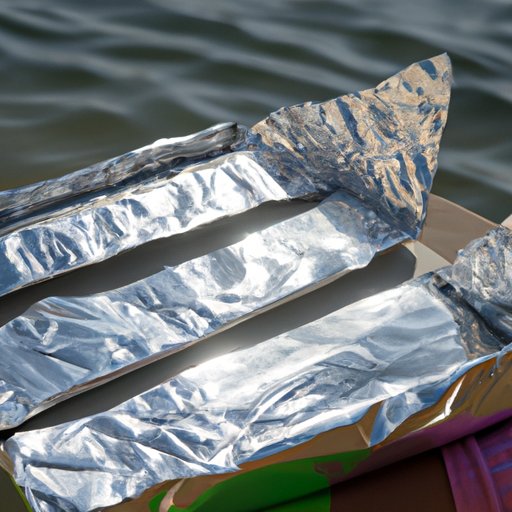
Introduction
Aluminum foil boats are a fun, creative way to explore the principles of buoyancy. It’s easy to make one out of just a few materials and can be used for a variety of educational and recreational activities. In this article, we’ll explore the science behind making aluminum foil boats, provide a step-by-step guide to building one, look at some of the different uses for them, and discuss tips for winning races.
A Step-by-Step Guide to Building an Aluminum Foil Boat
Building an aluminum foil boat is an easy process that only requires a few materials. You’ll need aluminum foil, scissors, tape, and a ruler. Start by cutting two rectangles of aluminum foil, each measuring 10 inches by 12 inches. Fold each rectangle in half lengthwise and then fold the edges up to create a boat shape.
Next, take one of the rectangles and cut a slit in the center of the top edge. This will be the opening for the boat. Then, cut two small slits in each side of the boat and insert the ends of the other rectangle into the slits. Secure the pieces together with tape. Finally, trim any extra foil to create a neat boat shape.
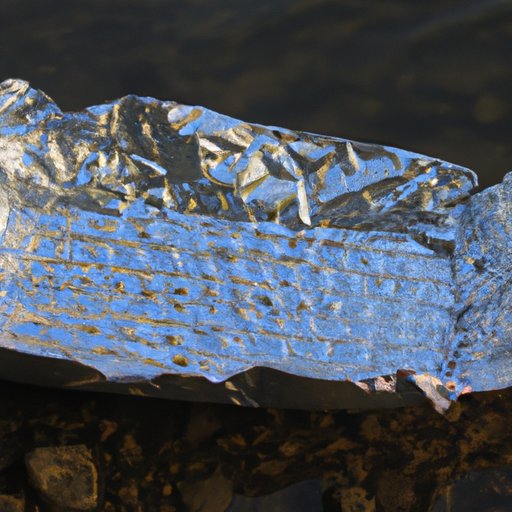
The Science Behind Making a Successful Aluminum Foil Boat
When it comes to making a successful aluminum foil boat, there are several factors that affect its floatability. The amount of weight the boat can hold before sinking, the speed at which it moves through the water, and the length of time it stays afloat are all important considerations. To make sure your boat is as successful as possible, you’ll need to understand the science behind buoyancy.
Buoyancy is the upward force that keeps objects afloat. It’s caused by the difference in density between the object and the surrounding liquid. When an object is less dense than the liquid, it will float. The more buoyant an object is, the longer it will stay afloat.
The shape of the boat also affects its buoyancy. A boat with a flat bottom will be more stable and will be able to carry more weight before sinking. Conversely, a boat with a pointed bottom will be less stable and will sink more quickly.
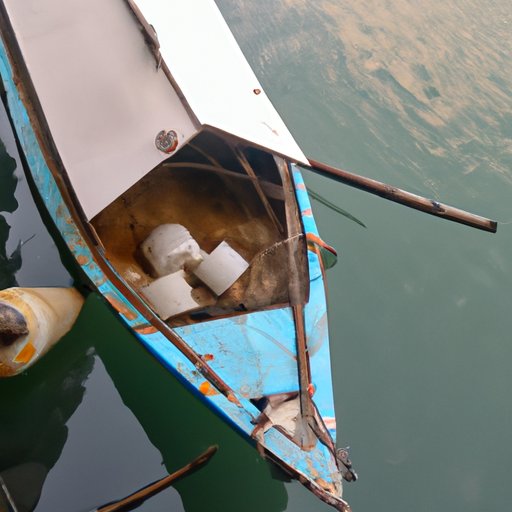
How to Make Your Boat Float Longer
If you want your aluminum foil boat to stay afloat for longer, there are a few things you can do. First, make sure your boat is well sealed. Any gaps or holes in the foil will allow water to seep in, making the boat heavier and more likely to sink. You can use tape to seal any gaps.
Second, add weights to the boat. You can use coins, stones, or other small objects to weigh down the boat and make it more buoyant. Be careful not to overload the boat, though, or it may sink. Finally, make sure the boat is properly balanced. If one side is heavier than the other, the boat will tilt and become unstable.
Exploring the Different Uses for Aluminum Foil Boats
Once you’ve built your aluminum foil boat, there are many ways to enjoy it. Here are some of the most popular uses for these boats:
Fun DIY Projects
Aluminum foil boats can be used for a variety of fun DIY projects. Try making a miniature sailboat, a remote control boat, or a boat with lights and decorations. You can even make a boat that looks like a pirate ship!
Educational Experiments
Aluminum foil boats can be used for educational experiments, too. Try testing different shapes, sizes, and weights to see how they affect the boat’s floatability. You can also experiment with adding different materials, such as paperclips, to see how they affect the boat’s performance.
Outdoor Activities
Aluminum foil boats can be used for outdoor activities, too. Try having a boat race with your friends or family, or use them to explore a nearby lake or pond. They’re also great for playing games such as “sink the boat” or “follow the leader”.
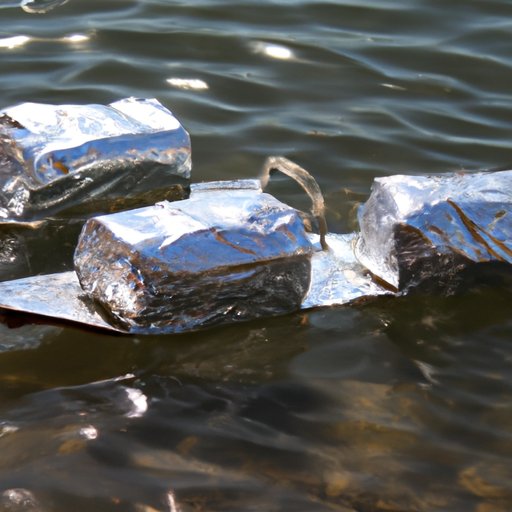
Aluminum Foil Boat Races: A Great Way to Have Fun with Your Friends
Aluminum foil boat races are a great way to have fun with your friends. All you need are a few boats and a large body of water. Before you start, make sure you know the rules and regulations for racing. Most importantly, make sure everyone is wearing a life jacket for safety.
To make sure the race is fair, set a course and decide on a starting point and finish line. You can also create obstacles along the course to make the race more exciting. Finally, make sure you have a timer to keep track of the race times.
Tips for Winning Races
If you want to win a boat race, there are a few tips you should keep in mind. First, make sure your boat is well-balanced and evenly weighted. Second, practice steering your boat and learn how to maneuver around obstacles quickly. Finally, make sure you have a good strategy for the race. If you can anticipate what your opponents are going to do, you’ll have a better chance of coming out on top.
How to Make an Aluminum Foil Boat That Floats for Hours
Making an aluminum foil boat that floats for hours isn’t as hard as it sounds. First, make sure your boat is well sealed and balanced. Next, add weights to the boat until it’s just barely floating. This will help it stay afloat longer. Finally, try using a special coating on the outside of the boat to make it more resistant to water.
To test your boat, place it in a tub or pool of water and see how long it takes to sink. If it sinks quickly, you’ll need to make adjustments to make it more buoyant. Once you’ve perfected your design, you’ll have a boat that will last for hours!
Aluminum foil boats are a fun and easy way to explore the principles of buoyancy. With just a few materials, you can make a successful boat that can be used for a variety of activities. Whether you’re looking for a fun DIY project, an educational experiment, or a challenging race, aluminum foil boats can provide hours of entertainment.
By understanding the science behind buoyancy and following the steps outlined in this article, you can make an aluminum foil boat that will stay afloat for hours.
Leave a Reply Cancel reply
Your email address will not be published. Required fields are marked *
Save my name, email, and website in this browser for the next time I comment.

- Board of Directors
- Immigration
- Virtual Museum
- Online Learning
- Learning With Primary Sources
- Engineering
- Mathematics
- Social Studies
- Professional Development
- Testimonials
- Advisory Council
- SHIPS – Immigration
- SHIPS – Transport
- SHIPS – Trade
- Contribute to PowerShips
- Search for: Search Button
Aluminum Foil Boats

ENGINEERING – Try this experiment that can be used for science, engineering, or technology, or computer science.
Share to Google Classroom
This task is a common introductory, team building, or instant invention activity used across many grade levels. An emphasis on science and engineering practices, critical thinking skills, and team building process skills is appropriate when used in this manner.
This lesson is from a computer science curriculum, but is applicable to any curriculum for introducing the importance of teamwork and problem solving and training students in classroom procedures. The aluminum boats problem could easily be substituted out for any number of other problems that require students to define their goals, devise a plan, try a solution, evaluate their results, and then iteratively improve. The problem chosen is intentionally “non-computational” and helps to frame it as one about problem-solving more generally with computer science being a new “tool” to help attack certain types of problems.
Scroll to the bottom to find out how other teachers adapted this lesson for their classrooms.
Learning Objectives
Students will be able to:.
- Communicate and collaborate with classmates in order to solve a problem
- Iteratively improve a solution to a problem
- Identify different strategies used to solve a problem
Education Standards
Next generation science standards.
- 3-5-ETS1-2. Generate and compare multiple possible solutions to a problem based on how well each is likely to meet the criteria and constraints of the problem.
- 3-5-ETS1-3. Plan and carry out fair tests in which variables are controlled and failure points are considered to identify aspects of a model or prototype that can be improved.
- Scale, proportion, and quantity
- Systems and system models
- Planning and carrying out investigations
- Constructing explanations (for science) and designing solutions (for engineering)
- Obtaining, evaluating, and communicating information
- MS-ETS1-2. Evaluate competing design solutions using a systematic process to determine how well they meet the criteria and constraints of the problem.
- MS-ETS1-3. Analyze data from tests to determine similarities and differences among several design solutions to identify the best characteristics of each that can be combined into a new solution to better meet the criteria for success.
Grades 9-12
- HS-ETS1-2. Design a solution to a complex real-world problem by breaking it down into smaller, more manageable problems that can be solved through engineering.
- HS-ETS1-3. Evaluate a solution to a complex real-world problem based on prioritized criteria and trade-offs that account for a range of constraints, including cost, safety, reliability, and aesthetics, as well as possible social, cultural, and environmental impacts.
Common Core
Writing Standards for Literacy in History/Social Studies, Science, and Technical Subjects
- WHST.6-8.1b Support claim(s) with logical reasoning and relevant, accurate data and evidence that demonstrate an understanding of the topic or text, using credible sources.
- WHST.6-8.2a Write informative/explanatory texts, including the narration of historical events, scientific procedures/ experiments, or technical processes. Introduce a topic clearly, previewing what is to follow; organize ideas, concepts, and information into broader categories as appropriate to achieving purpose; include formatting (e.g., headings), graphics (e.g., charts, tables), and multimedia when useful to aiding comprehension.
Grades 9-10
- WHST.9-10.2a Write informative/explanatory texts, including the narration of historical events, scientific procedures/ experiments, or technical processes. a. Introduce a topic and organize ideas, concepts, and information to make important connections and distinctions; include formatting (e.g., headings), graphics (e.g., figures, tables), and multimedia when useful to aiding comprehension.
Grades 11-12
- WHST.11-12.2a Write informative/explanatory texts, including the narration of historical events, scientific procedures/ experiments, or technical processes. Introduce a topic and organize complex ideas, concepts, and information so that each new element builds on that which precedes it to create a unified whole; include formatting (e.g., headings), graphics (e.g., figures, tables), and multimedia when useful to aiding comprehension.
Preparation
For each group
- 2 sheets of aluminum foil, 5×5 inches in length each
- 1 container that can hold 3-5 inches of water
- Several paper towels or rags that can be placed under the container
- One copy of the Aluminum Boats Student Activity Guide
Activity (30 min)
Group : Put students in groups of 2 or 3.
Support: Give students a couple minutes to discuss in groups the approach they will take with this first boat. Once groups have recorded their ideas and some possible weaknesses, they can come to you to get their aluminum foil and begin building their boats.

Once groups are ready, have them test their boats by dropping individual pennies into the boat. Remind them of the rules, specifically that they can’t touch or adjust the boats once they’re in the water. Have them record the total number of pennies held on their activity guides.
Iterative Improvement
Share: Have students share the results of their first run with neighboring groups. Ask groups to focus particularly on what the eventual failure of their boat was (e.g. it wasn’t deep enough, it was unstable, etc.) and brainstorm ways to get around those problems.
Prompt: Now that you’ve had a chance to learn from the first round of boatmaking, let’s run the same activity again. First, your group will develop a new plan. Just as before, record it on your activity guide, and once you’re ready I’ll come around and give you a new piece of foil.
Support : As you circulate from group to group, ask questions about the group’s focus in redesign. EX: “What aspect of your boat needed the most improvement?” “What ideas from other groups did you want to incorporate to yours?” “Did you feel the need to completely restructure your boat, or make minor modifications?”
Once groups have prepared their new plans give them a new piece of foil and have them each build a new boat.
Groups can test their designs just as before and record the results on their activity guides.
Transition : Ask class to return to their own seats to reflect on the activity.
Wrap Up (10 mins)
Discuss the challenge.
Prompt : What was your favorite part of this activity? What was most challenging?
Discuss : Allow students time to share thoughts with the class.
Discussion Goal – This should be a fairly open-ended discussion of the different components of the activity. Feel free to ask follow up questions if you like but the main goal is just to kick off the later conversation.
Prompt : Since you are in a computer science class, you also may be wondering, “What in the world did that have to do with computer science?” Find another partner and talk about what you think this activity has to do with computer science.
Discuss : Allow students an opportunity to share their responses with the class.
Although there are no right or wrong answers for this discussion, for our purposes, the main point is that students solved a problem. They had to define the problem, plan a solution, try a solution, and evaluate it.
Teaching Tips:
- This activity can get your room wet! Ideally, each group should have its own bucket/container with water to conduct its own tests. If needed, you can have several groups share one container, but be mindful to set guidelines for sharing that container. Place towel/rag under each container. You may also want to consider having this activity in the hallway or some other space if your room is very restrictive.
- Hold onto the foil until students submit a plan for their boat. The goal isn’t to slow them down too much, but just give them a moment to reflect briefly on the possible approaches they could take.
- While some students will view this portion as a competition, emphasize that each group is looking to improve its own design, not competing against others. You are appealing for each student to challenge themselves first, not others.
Adapted Lessons:
STEM Boat Challenge – View how Timothy Baszak used this lesson in his STEM class for grades 5-8 at Waypoint Academy.
Additional Resources
- Article: How to Encourage STEM in Early Education , Juni Learning.
- Lesson: What Floats your Boat , Teach Engineering, University of Colorado.
- Collaborative Learning and Group Work Rubric – Emelina Minero, “ Using Collaborative Learning to Build Student Agency ,” Edutopia.
Additional Education Standards
Internal society for technology in education (iste) standards for students.
ISTE Standards•S 4 Innovative Designer – Students use a variety of technologies within a design process to identify and solve problems by creating new, useful or imaginative solutions.
- Students know and use a deliberate design process for generating ideas, testing theories, creating innovative artifacts or solving authentic problems.
- Students develop, test and refine prototypes as part of a cyclical design process.
- Students exhibit a tolerance for ambiguity, perseverance and the capacity to work with open-ended problems.

This page is a derivative of Lesson 1: Intro to Problem Solving by Code.org used under CC BY-NC-SA 4.0 and is licensed under the same license by SSHSA. For more Computer Science lessons, check out Code.org.
Share this:
- Click to share on Twitter (Opens in new window)
- Click to share on Facebook (Opens in new window)
- Click to share on Pinterest (Opens in new window)
- Click to share on LinkedIn (Opens in new window)
- Click to email a link to a friend (Opens in new window)

Be Bold. Be Antifragile.

Don't miss another video, subscribe to our channel
Alubat [al.u.bat] noun | Aluminium Bateau | Aluminum Boat

Open House at Alubat
Join us at the Alubat boatyard in Les Sables d’Olonne, France for our Open House this coming May 31 to June 1 and get on board a new OVNI 370 and OVNI 430.

Amazing 43-ft Aluminum Sailboat
Full-time cruisers Roberta and Duca stopped by to visit us during the La Rochelle Boat Show for a tour of the NEW Ovni 430.

The ‘Small’ Huge Sailboat
Tour of the new Ovni 370 with Duca and Roberta on their YouTube channel Odd Life Crafting.

Aluminum Sailboat Misconceptions
“I have a friend, who knows a guy, who has a cousin, that bought an aluminum boat, and after a week in the marina the bottom fell out of her”.

Alubat Pricing
How Much Does a Well-Equipped Alubat Ovni Cost? Find out how we price the Ovni range of aluminum sailboats for the serious off-shore cruiser.

OVNI 490 Preview
The 490 shares some of the hallmarks of the Ovni range: shaft drive, full sailplan, centerboard, and spacious interior with a raised salon layout.

50 years of sailing excellence!
FIGARO nautisme | by François Tregouet
Half a century old and still thriving, Alubat, the Vendée-based shipyard, is not content with just being one of the world’s benchmarks in ocean cruising with its iconic Ovni yachts. Instead, with the enthusiasm of youth, it is preparing to launch three new monohulls over the next two years.
Link to read article [PDF]
STRENGTH ACROSS THE FULL RANGE OF ALUBAT SAILBOATS

The new generation OVNI 370 with an inverted bow for improved performance and expanded the interior volume.

The new generation OVNI 430 with an inverted bow for improved performance and expanded the interior volume.

The OVNI 450 stands out from the OVNI range and maintains a traditional cabin top styling.

What sets the OVNI 490 apart are the protected pilot house and twin engines.
Designing and building aluminum boats for blue water sailing.
The Alubat shipyard has been designing and building aluminum boats for blue water sailing since 1973. With more than 1,600 yachts built and with 50 years of expertise in metal work and carpentry, Alubat has unparalleled experience in the aluminum sailboat market.
Discover More

Aluminum is green
By having the ability to beach your boat, inspecting and servicing your yacht becomes less daunting than having to haul out.
beach your boat

Go places where other sailboats can't.
Centerboard advantages, navigate shallow water.
From the turquoise waters of the Bahamas to the Alaskan ice fields, a lifting keel gives you the peace of mind to navigate in shallow water.
The centerboard doesn’t sacrifice performance or safety, in fact, it can enhance performance when it comes to downwind sailing.

Another advantage of a centerboard is the expanded possibilities to find docking in marinas that would otherwise be too shallow for a fixed keel sailboat.
Without the limitations of fixed keel boats, your cruising opportunities can take you through the maze of Europe’s ancient canals and the historic North American waterways.
The centerboard can be lifted manually or by using a hydraulic system.

Aluminum Foil Boats
NOTE: This tutorial is part of a bundle of 36 STEM Activities! Check out “STEM for the Whole Year” in my TpT Store!
In this activity, students will work in groups to design and build a small boat from aluminum foil. They will then see how many pennies it can hold before it sinks. The goal is for each student to work with their group to build and modify their boat to hold as many pennies as possible.
Materials (per group, 3-4 students):
• 2 Aluminum foil squares that are 15cm by 15cm (second square is for mistakes or redesigns) • 1 Beaker or clear cup (to show the aluminum foil and penny sinking at the beginning of this activity) • Approx. 50 pennies (in a small cup) • A fish tank / large bowl for setting boats in when filling with pennies (1 tank per class)
Video Tutorial:
Check out the Aluminum Foil Boats Activity in my TpT Store! It includes this video along with a worksheet, teacher instructions, grading rubric and planning sheet! Click on one of the links below to check it out!
Aluminum Foil Boats STEM Activity Challenge
k-2 Grade Aluminum Foil Boat Activity 3-5th Grade Aluminum Foil Boats Activity 6-8th Grade Aluminum Foil Boats Activity

- 2024 BOAT BUYERS GUIDE
- Email Newsletters
- Boat of the Year
- 2024 Freshwater Boat and Gear Buyers Guide
- 2024 Boat Buyers Guide
- 2024 Water Sports Boat Buyers Guide
- 2023 Pontoon Boat Buyers Guide
- Cruising Boats
- Pontoon Boats
- Fishing Boats
- Personal Watercraft
- Water Sports
- Boat Walkthroughs
- What To Look For
- Best Marine Electronics & Technology
- Watersports Favorites Spring 2022
- Boating Lab
- Boating Safety

Using Hydrofoils to Improve Boat Performance
- By Capt. Vincent Daniello
- March 15, 2024
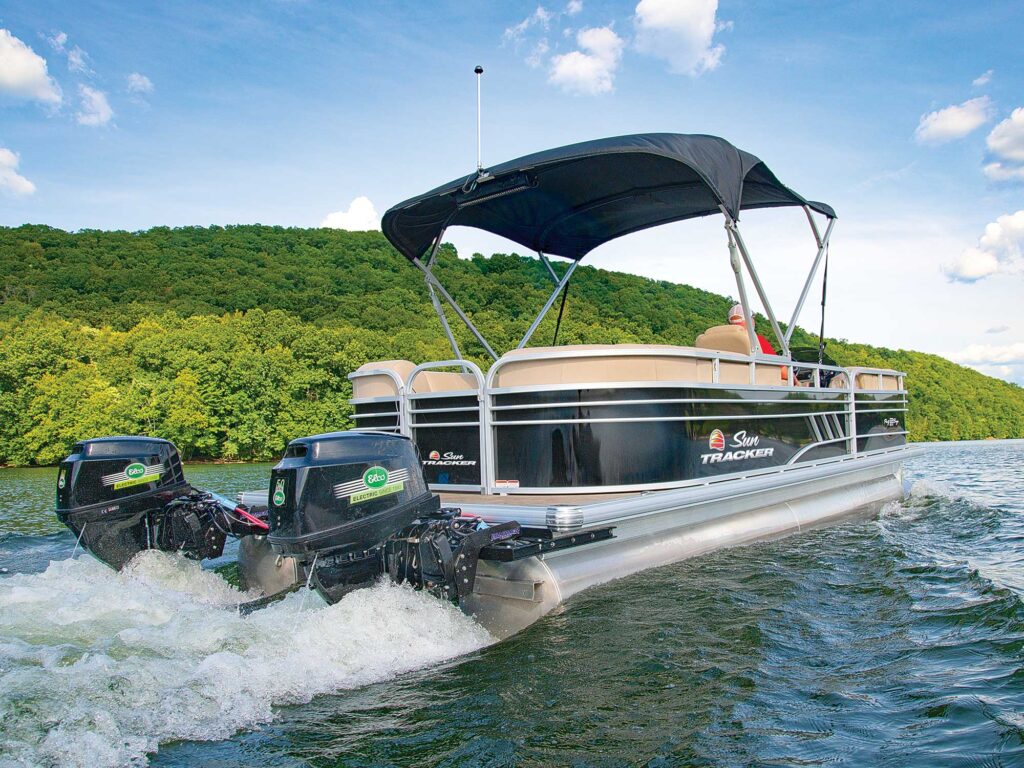
In my early days as a captain, few boats cruised faster than 30 mph. Back then, bigger engines and the fuel they burned added too much weight, netting little more speed. Today, even modest performers top 50 mph thanks to lighter engines and boat construction, where more ponies push fewer pounds.
Electric propulsion leaves boats yet again struggling in that extra-pounds paradigm. Adding fuel— measured in kilowatt-hours of lithium batteries—attenuates attempts to go faster and farther, at least until batteries become lighter. But there might be another way. I tested an electric-powered SunTracker Party Barge 22 DLX both before and after Hydrofin installed its hydrofoil system, which lifts a boat while moving through the water. This effectively overcame 800 pounds of lithium iron phosphate (LiFePO4) batteries—40 kilowatt-hours—that fueled twin Elco EP-50 electric outboards. In the end, flying on foils increased the boat’s speed by well more than a third and improved efficiency markedly. So, what are hydrofoils, and can they enhance performance aboard other boats too?
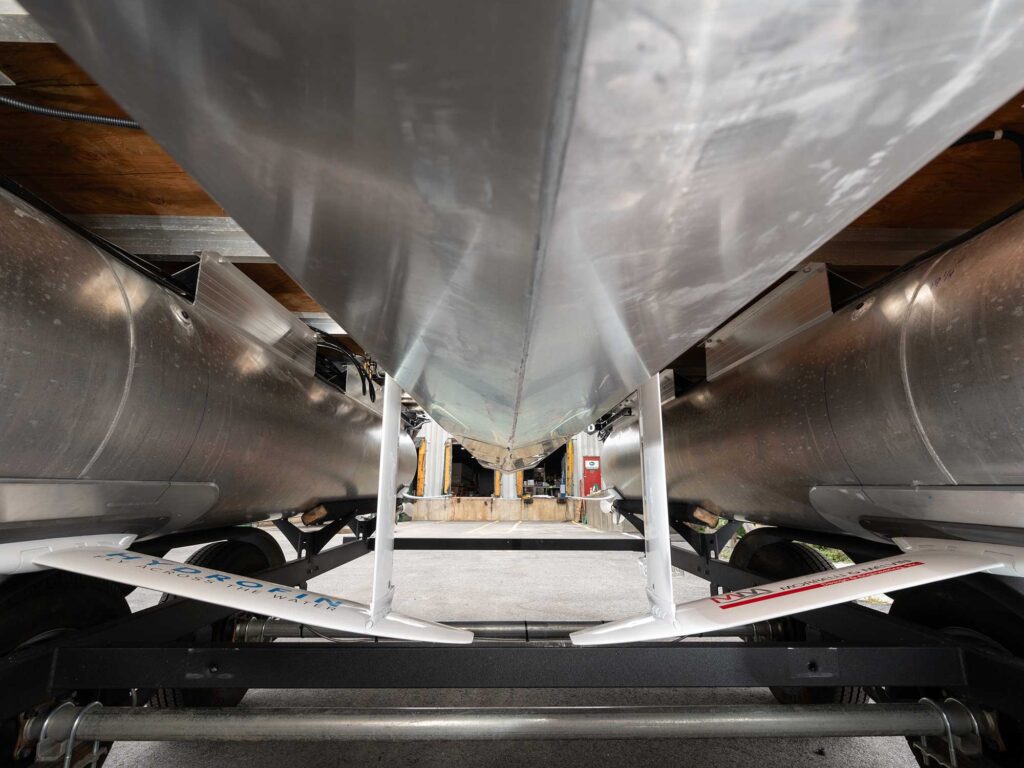
Performance Takes Flight
“We’re a long way from batteries that provide lightweight energy. Our hydrofoils create lift to overcome that additional weight,” says Jason Minor, Hydrofin’s founder. The patented system, engineered by noted catamaran and America’s Cup sailing foil-design firm Morrelli & Melvin of Newport Beach, California, utilizes powder-coated aluminum foils—essentially underwater wings. Mounting pads epoxied to hulls allow incremental adjustment of location and angle of attack, so Hydrofin foils lift nearly half a boat’s weight. “A typical bi-toon with a gas 150 runs around 30 mph. Adding Hydrofin foils can easily make it run 37 to 39 mph,” Minor says, adding that 30 percent better economy is common at cruising speeds. Riding higher on wings makes boats run smoother, dryer and quieter too. (See our Hydrofin test on a Misty Harbor 2528 pontoon with a Merc 150 hp gas outboard at boatingmag.com/hydrofin .)
Put to the Test
Hydrofin foils lifted so much battery weight that our Elco-powered test boat required larger propellers to see full improvement. Comparing performance from the final propellers, with foils removed, the boat reached 17.2 mph turning just 5,400 rpm and drawing an overloaded 67.2 kW. With Hydrofin foils installed, those same props turned 5,750 rpm to reach 24.9 mph at 58.56 kW. The original propellers, without hydrofoils, reached 6,000 rpm and 17.9 mph while consuming 49.06 kW, which we used to compute 39 percent increased speed and 16 percent improved efficiency with hydrofoils installed.
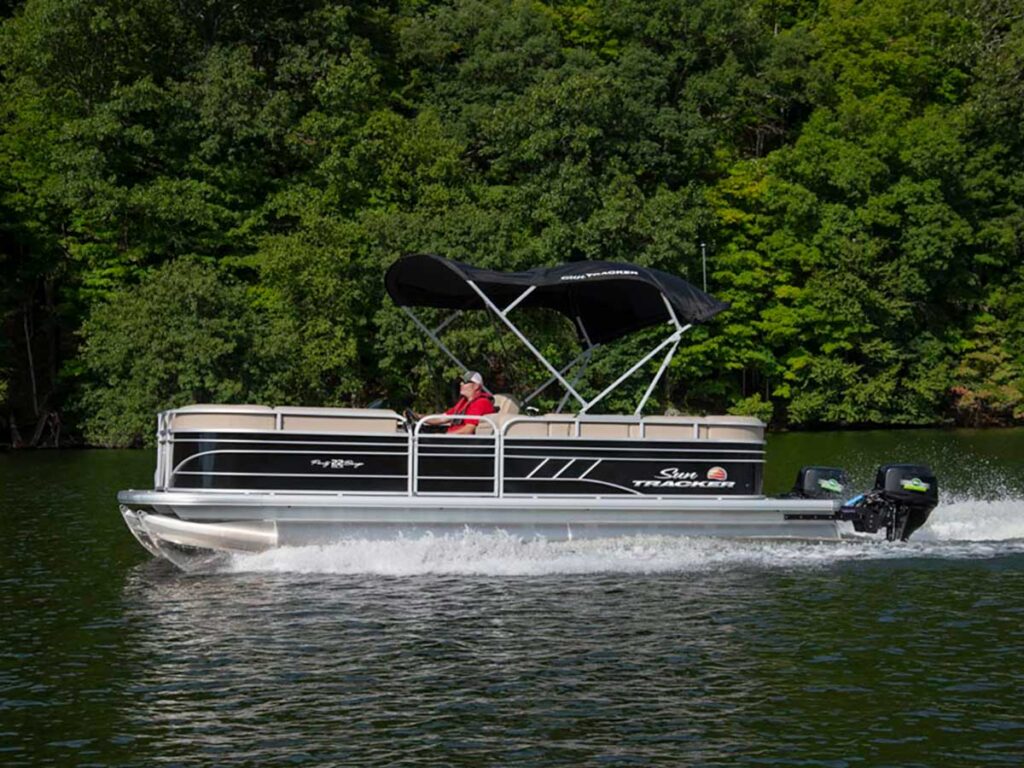
Worth the Weight
Minor says that about one-third of installations benefit from new props, which is expected when essentially lightening a boat by half. Those underwater wings alleviate passenger weight too, which often impacts gas-powered pontoon boatspeed. “A boat might lose 6 or 8 mph when full of people,” Minor says, versus carrying minimal crew. “That same boat would see just a 2 or 3 mph drop with our hydrofoils installed.”
Tri-toons, with lift from a third hull and planing strakes, tend to benefit a bit less. Minor says that gas tri-toons typically see 15 to 25 percent increase in speed or fuel economy. On a 25-foot Qwest Tri-toon powered with a prototype 350 hp equivalent Hyper Electric outboard and 1,150 pounds of batteries, Minor reported that the boat gained from 15 percent to 29 percent efficiency in the 20 to 35 mph cruising range. Hydrofin foils proved 7 percent more efficient at 43 mph, which was wide-open throttle without the foils, and they added 6 mph top speed, reaching 49 mph at the same 270 kW. (See our test of the Hyper Electric in Motorhead on page 74.)
Foil Downsides
While Minor was installing the Elco-powered test boat’s foils—about a half-day procedure—I kept an eye out for pitfalls. Foils increase draft by about 4 inches, but they’re mounted well aft of amidships, where they shouldn’t interfere at most beaches. Modifying the boat trailer’s inner bunk impacted aligning the boat back onto the trailer at the ramp, but this can be easily remedied with side guide pipes common on monohull trailers. In a hard grounding or collision, foils are engineered to break away, and Minor reports no damage to hulls or mounting pads, only foils themselves, in the few times it has occurred. Operating in very shallow water would surely be problematic, but Hydrofin’s optional electric-actuated system fully retracts well above a pontoon’s bottom.
Other Boats
Hydrofin’s system adapts to nearly all pontoon and tri-toon boats, and they’ll work on small power catamarans but not monohulls. “The foils need a gap away from the hull,” Minor explains, which comes when they’re mounted between two hulls. Hydrofin’s foils also won’t work past about 55 mph, when water flow causes foil cavitation.
Long-standing wisdom maintains that more ponies pushing fewer pounds increases speed. That’s still true, but Hydrofin shows that boats can also grow wings and fly.
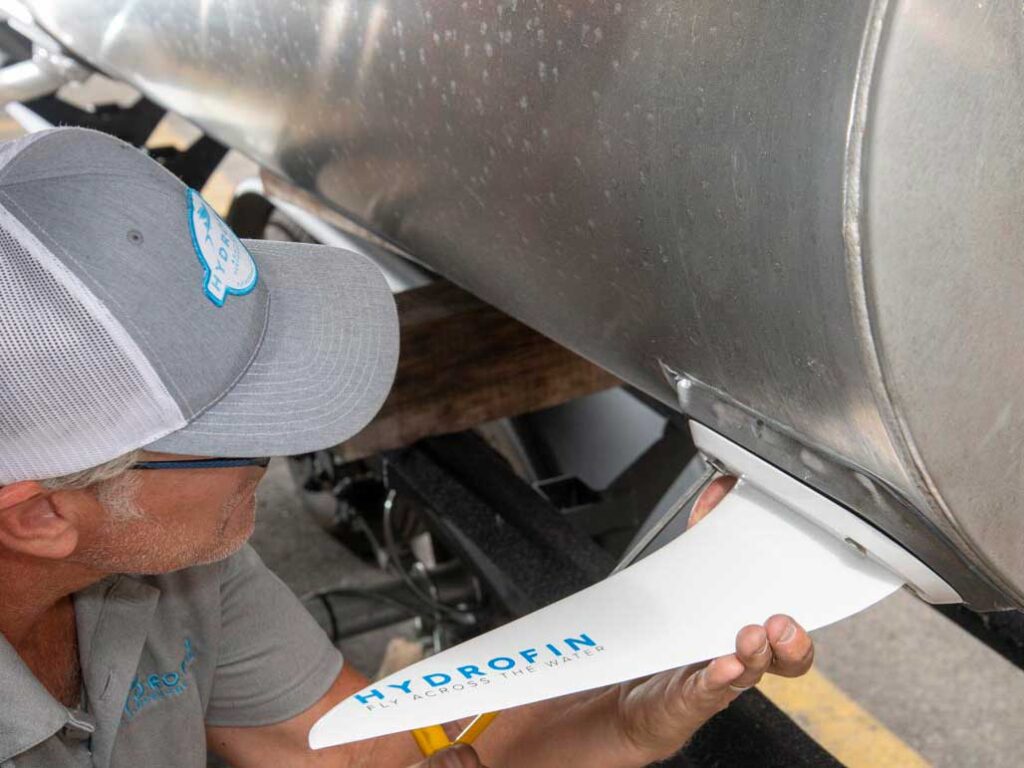
How Hydrofin Foils Attach to the Hull
On twin-hull boats, Hydrofin hydrofoils mount to pads epoxied to hulls between pontoons, with braces extending upward to the deck. Foil location and angle of attack adjust fore-and-aft trim and total lift. Finlets mounted aft add more lift to further tweak the boat’s ride and trim.
Oversize fins, chosen to carry battery weight, range from 343 to 1,822 pounds lift at 25 mph.
Tri-toons utilize a modified mount and fins that create from 537 to 1,021 pounds of lift at 25 mph, where a 25-foot Qwest tri-toon with Hyper Electric Marine’s 350 hp electric outboard was 29 percent more efficient with Hydrofin foils installed, while top speed increased by 6 mph, according to Hydrofin.
- More: April 2024 , boat building , Boats
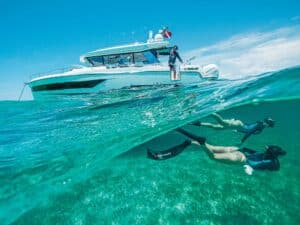
Six Boats Built for Adventure
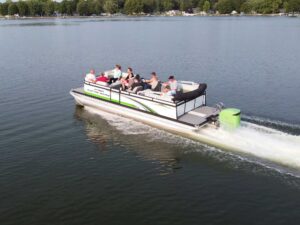
Hyper Electric Marine’s Electric-Outboard Pontoon Boat

Modern Pontoons Are Built for a Variety of Boating Styles

Can a Unibody Truck Easily Tow a Boat?

Garmin EchoMap Ultra 2 Series
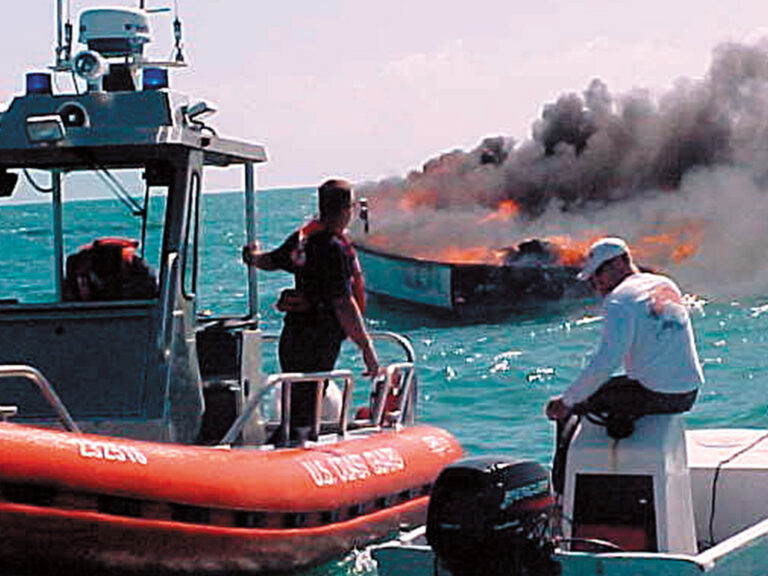
Should You Abandon Ship During a Boat Fire?
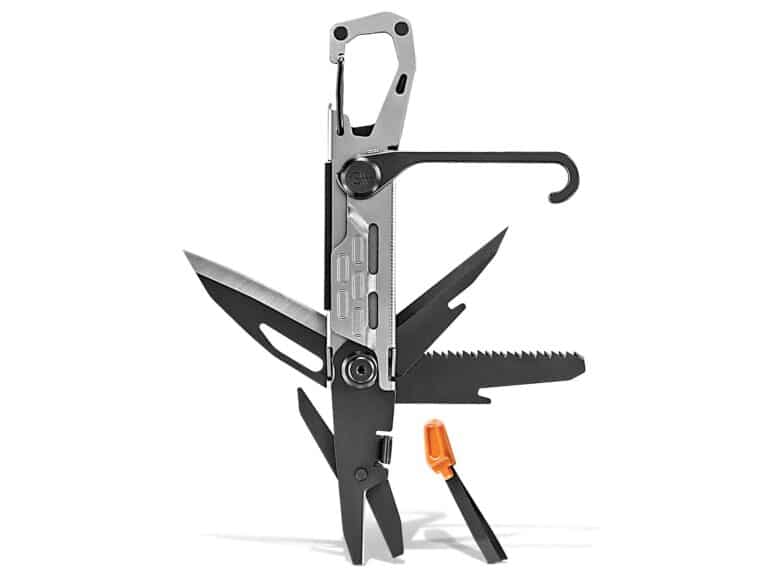
Top Gear for Boating Adventures
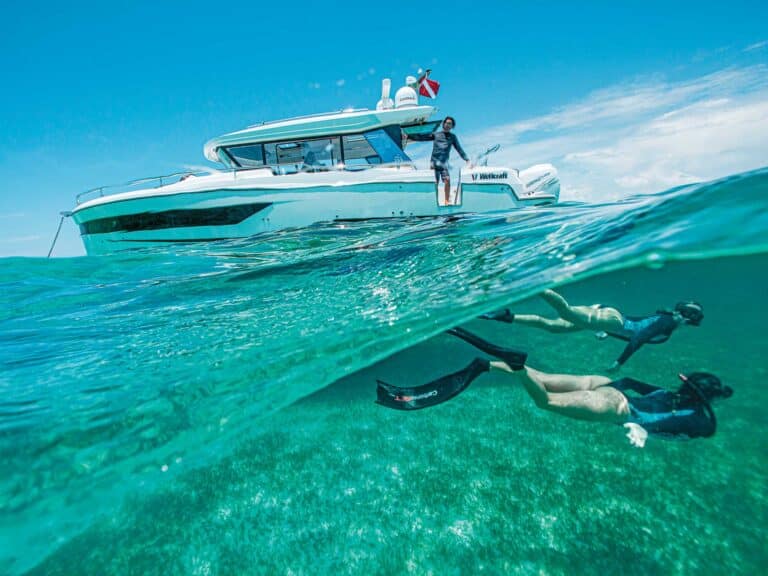
- Digital Edition
- Customer Service
- Privacy Policy
- Terms of Use
- Cruising World
- Florida Travel + Life
- Sailing World
- Salt Water Sportsman
- Sport Fishing
- Wakeboarding
Many products featured on this site were editorially chosen. Boating may receive financial compensation for products purchased through this site.
Copyright © 2024 Boating. A Bonnier LLC Company . All rights reserved. Reproduction in whole or in part without permission is prohibited.

IMAGES
VIDEO
COMMENTS
Instructions. Cut two squares of aluminum foil, making one square have dimensions that are twice that of the other square. For example, you could make one square be 12 inches by 12 inches (or 30 centimeters [cm] by 30 cm), and make the second square be 6 inches by 6 inches (or 15 cm by 15 cm). Fold the two aluminum foil squares into two ...
Make a Toy Sailboat: building a cork sailboat is very simple, but it may take a little experimenting to get your boat to sail straight — there's a science trick to it! Make Your Drawings Float!: explore how the properties of materials determine whether or not they float. My Pick of the Day: Building and Sinking Aluminum Foil Boats
These boats are designed to harness the power of wind, utilizing a sail to propel them forward. Building a tin foil sailboat requires some additional materials, such as a small stick or toothpick for the mast and a piece of paper or cloth for the sail. To create a tin foil sailboat, start by building the basic boat shape using aluminum foil.
Ahoy Friend!In today's tutorial we are going to set sail for the high seas and practice our boat building skills as we learn a bit about buoyancy! Let's buil...
Cut out the square. This will become the metal "boat" you test. • Mark the four corners of the aluminum foil square with permanent marker. • Be careful: later in the experiment you will use ...
The materials list for the Simple STEM Aluminum Boat Lab is short and super inexpensive! All you need is some aluminum foil sheets and marbles. I purchased both of these from the Dollar Tree. You will more than likely need 2 to 3 bags of marbles and just 1 box of aluminum foil sheets. So, for less than $5 dollars, your student can experience an ...
The aluminum foil boat challenge also known as the penny boat challenge is a fun STEM lesson for kids of all ages. This is an easy and fun science experiment that can be done at home or in a classroom. The object of the penny boat challenge is simple, your child will design and build a boat from aluminum foil and see how many pennies it can ...
Crafting an aluminum foil boat using a tissue box structure and adding a foam sheet sail is an enjoyable project that combines creativity and exploration. It allows you to learn about buoyancy, stability, and the effects of wind on sailboats while igniting your imagination. So, gather your materials, set sail on your DIY adventure, and let your ...
The classic "aluminum foil boats and pennies" project. In this lesson plan, we take a twist on the boat building activity to add some additional engineering steps and real-world context, and encourage students to exercise their problem-identification and solving skills. This lesson is anchored in the fact that humans have been using boats for ...
Materials (per group, 3-4 students): 2 aluminum foil squares that are 15cm by 15cm (1 square will be in case they make a mistake or want to redesign their boat) 1 beaker or clear cup (to show the aluminum foil and penny sinking at the beginning of this activity) approx. 50 pennies (I put these in a small cup) A fish tank / large bowl for ...
You'll need to double the aluminum foil. I think heavy duty foil works best. Make a boat shape by bending and folding the foil. Cut a triangular sail from paper. Use a bendable straw for the mast. Bend the straw, and tape the short end to the bottom of your boat. Decorate the sail any way you like. I didn't have much luck with the aluminum foil ...
Participants design and build a boat from aluminum foil that holds as many pennies as possible before it sinks or capsizes, learning about buoyancy, density, and displacement. Time 45 minutes or Less Careers Materials Science Grade 3-5 Topic Design Challenge ...
10. New Zealand 'R' Class skiff. In New Zealand they love their skiff sailing, and development classes like the doublehanded 'R' Class are prime for new features. The 'R' Class started its project to get the fleet foiling back in 2008 and now there are a clutch of boats racing.
Design and construct boats out of aluminum foil and see how many pennies they can hold before they sink. Try this fun experiment today! Aluminum Foil Boat Experiment Activity Sheet. Aluminum Foil Boat was part of our Week 4 Theme: Density & Floating. What other projects from this theme did you participate in?
For example, make sure the aluminum foil is folded/crimped tightly. If there are cracks or gaps, water may seep in. Try adding pennies to the boat one at a time until it sinks.
Aluminum foil boats are a fun and easy way to explore the principles of buoyancy. With just a few materials, you can make a successful boat that can be used for a variety of activities. Whether you're looking for a fun DIY project, an educational experiment, or a challenging race, aluminum foil boats can provide hours of entertainment. ...
2 sheets of aluminum foil, 5×5 inches in length each. 1 container that can hold 3-5 inches of water. Several paper towels or rags that can be placed under the container. 15 pennies. One copy of the Aluminum Boats Student Activity Guide.
Sheets of aluminum foil (30 x 30 cm) Tub of water; Pennies or paper clips; Instructions. Design and build a boat with one sheet of foil. Float boat in the tub of water. Add pennies or paper clips one at a time into the boat. Design a new boat to hold more weight! Extensions
Activities at Home:Aluminum Foil Boats Part 1: The ExperimentAluminum Foil Boats Part 2: The Science Behind Them : https://youtu.be/-O5LFU4TUlM
The Alubat shipyard has been designing and building aluminum boats for blue water sailing since 1973. With more than 1,600 yachts built and with 50 years of expertise in metal work and carpentry, Alubat has unparalleled experience in the aluminum sailboat market. Discover More.
Try building some different boats using the same amount of aluminum foil for each. Also try building some different boats using different amounts of aluminum foil. Some different shapes you could try include making the hulls have two pointed ends (like canoes), like the ones on the left in Figure 1, or be square or rectangular (like a ...
Materials (per group, 3-4 students): • 2 Aluminum foil squares that are 15cm by 15cm (second square is for mistakes or redesigns) • 1 Beaker or clear cup (to show the aluminum foil and penny sinking at the beginning of this activity) • Approx. 50 pennies (in a small cup) • A fish tank / large bowl for setting boats in when filling with ...
Even though the bottom of the foil is about a foot lower than the hulls, its extruded aluminum construction is stout enough to withstand being gently beached. Time to Fly. Switching boats, we were curious to feel the difference the foil makes. The experience was subtle. The Hydro Glide foil is positioned just forward of the boat's ...
Put to the Test. Hydrofin foils lifted so much battery weight that our Elco-powered test boat required larger propellers to see full improvement. Comparing performance from the final propellers, with foils removed, the boat reached 17.2 mph turning just 5,400 rpm and drawing an overloaded 67.2 kW.